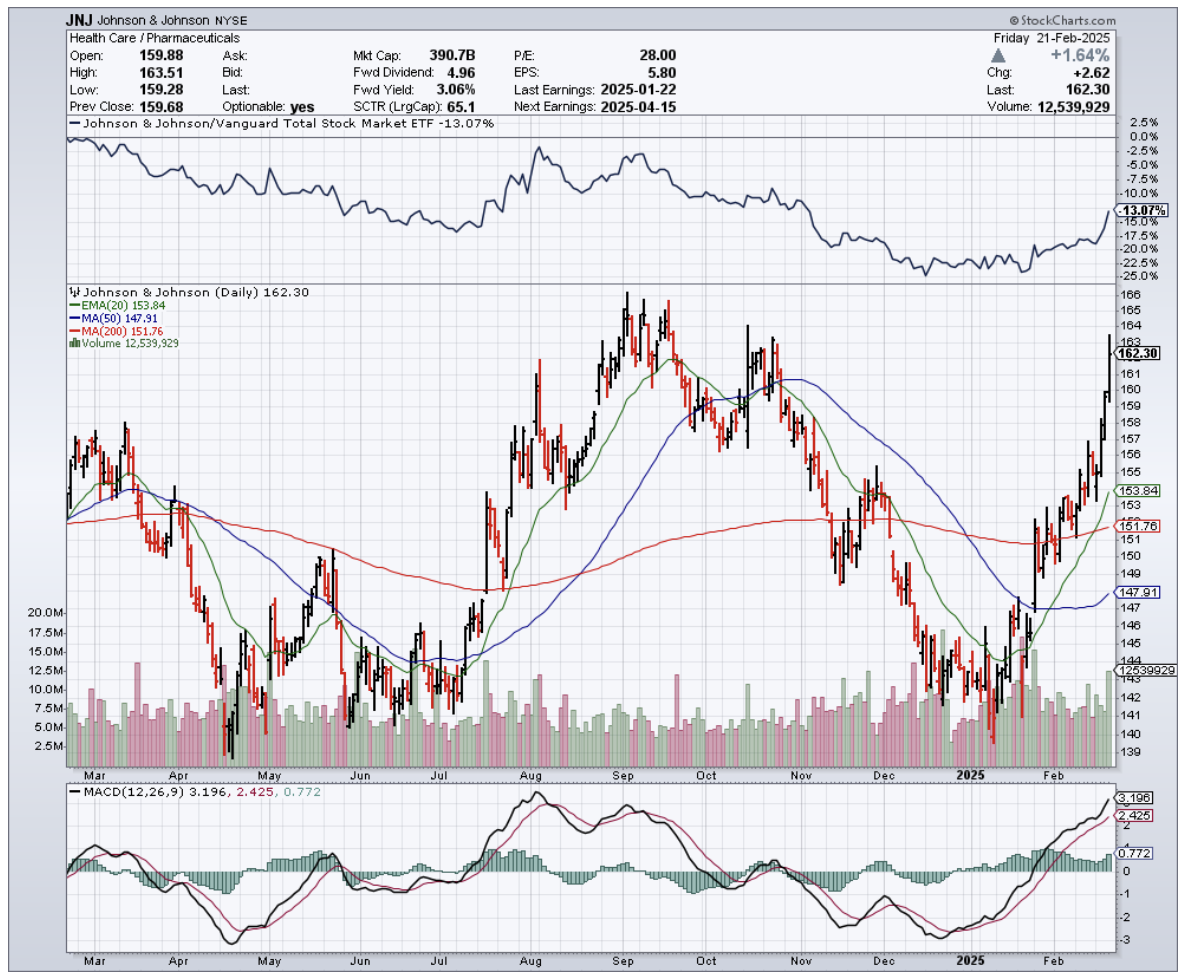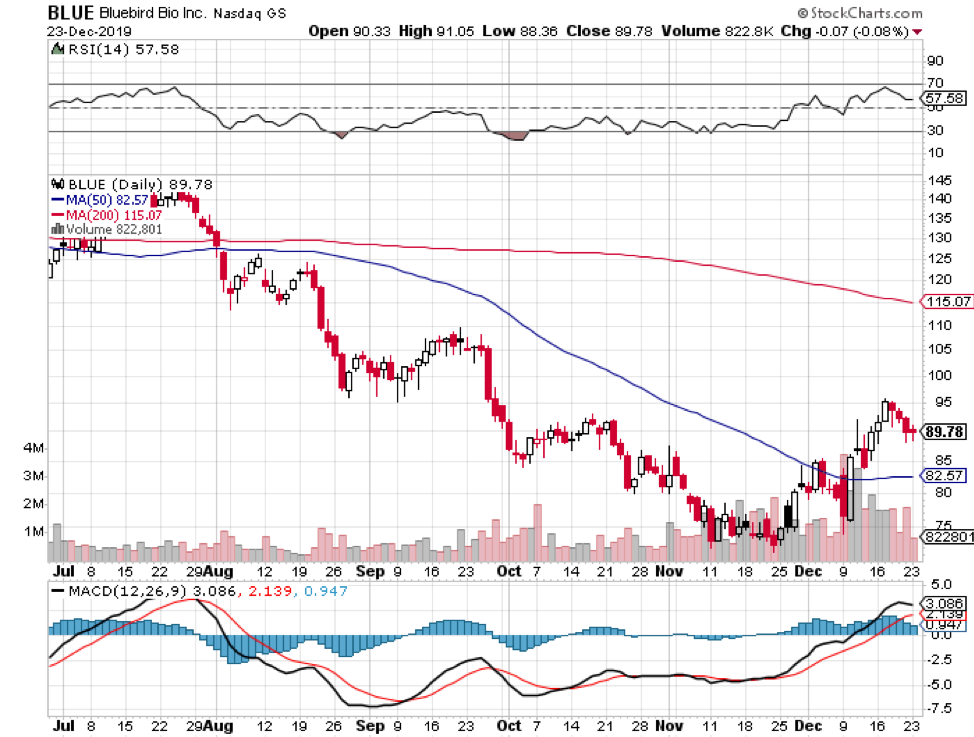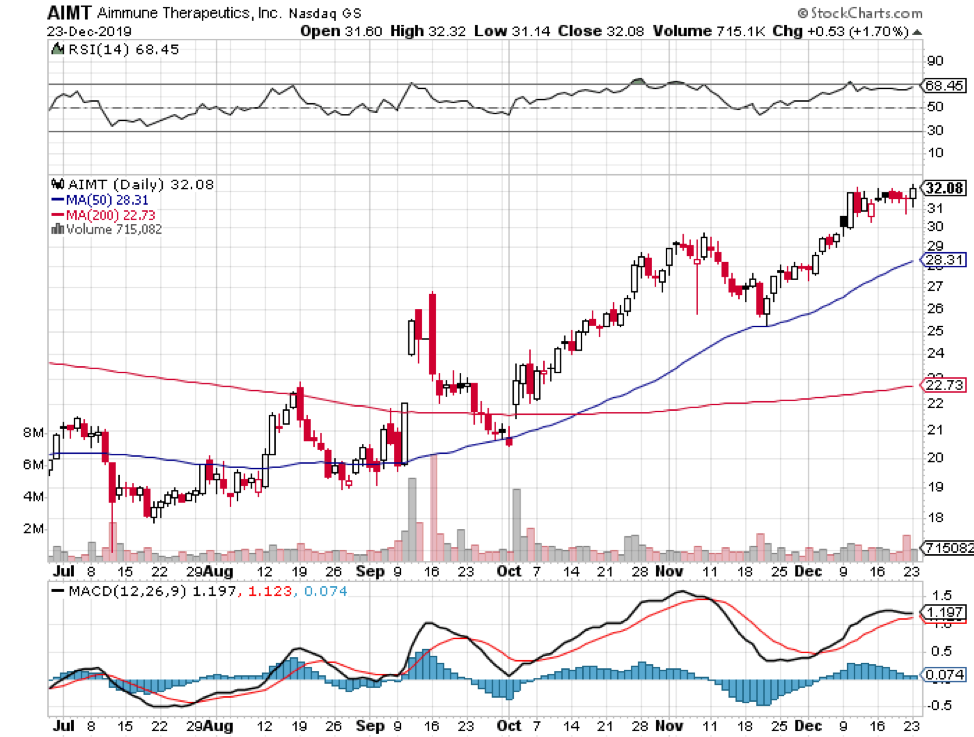Mad Hedge Biotech and Healthcare Letter
February 27, 2025
Fiat Lux
Featured Trade:
(THE KENNEDY-ERA STOCK THAT'S STILL PAYING MY DINNER BILLS)
(JNJ), (ITCI)

Mad Hedge Biotech and Healthcare Letter
February 27, 2025
Fiat Lux
Featured Trade:
(THE KENNEDY-ERA STOCK THAT'S STILL PAYING MY DINNER BILLS)
(JNJ), (ITCI)

The other day, while sorting through my oldest trading records (yes, I keep everything), I found my first Johnson & Johnson (JNJ) dividend check from decades ago. It wasn't much—just enough for a nice dinner back then.
But here's the kicker: that dividend has grown every single year since, weathering oil shocks, dot-com bubbles, financial crises, and even pandemics. It got me thinking about what truly makes a fortress stock in today's market.
While everyone's chasing the latest biotech and healthcare moonshot, JNJ has been quietly building an empire.
With a market cap of $375 billion and revenue growing at an impressive 7.55% annual clip since the 1980s, this company has accomplished something few others have—long-term, consistent growth while raising dividends for over six decades. And then there's the balance sheet.
JNJ is sitting on $25 billion in cash against $38 billion in total debt, resulting in a covered ratio of 29.4. That means they could pay their debt service with spare change found in their corporate couch cushions.
Some investors dismiss JNJ as just another mature healthcare stock, but that perspective overlooks the quiet revolution happening within the company.
In the first two months of 2025 alone, JNJ secured multiple FDA approvals. The most notable? SPRAVATO, the first and only monotherapy for treatment-resistant depression. And they're not stopping there.
JNJ recently announced a $14.6 billion acquisition of Intra-Cellular (ITCI), securing CAPLYTA, a blockbuster drug for bipolar disorder and schizophrenia.
With the global Central Nervous System therapeutics market projected to grow at a 10.5% CAGR through 2034, JNJ is strategically positioning itself for future expansion.
What's particularly impressive is how JNJ has transformed its research and development approach. They're not just throwing money at problems—they're getting smarter about their investments.
Their R&D success rate has been climbing, with a higher percentage of late-stage trials making it to market compared to industry averages. This isn't by accident.
JNJ has been leveraging artificial intelligence and machine learning to better predict which compounds are most likely to succeed, potentially saving billions in development costs. It's like having a crystal ball in the lab, and it's giving them a significant edge over competitors who are still using traditional development methods.
Despite its fortress balance sheet and track record of reliability, JNJ is currently trading at a discount to historical averages.
Its forward P/E ratio sits at 15.8, compared to a five-year average of 17.9. The dividend yield is at 3.18%, higher than its 10-year average of 2.7%. Its price-to-sales (P/S) ratio stands at 4.4, below its five-year average of 4.8.
These numbers suggest the market is underpricing JNJ's resilience and growth potential.
Of course, no investment is risk-free. JNJ is facing looming patent expirations on key drugs, including Stelara, which generated $10.3 billion in 2024 sales, and Xarelto, which brought in $2.3 billion.
However, history suggests that patent cliffs aren't a new challenge for JNJ—they've successfully navigated them for decades. Their strong drug pipeline, along with strategic acquisitions, should help offset any revenue declines.
Beyond pharmaceuticals, JNJ's business diversification is a major advantage.
With roughly two-thirds of revenue coming from Innovative Medicine and the remainder from MedTech, and with 43% of total revenue sourced outside the U.S., this diversified revenue mix helps mitigate risks tied to any single product or market.
What many investors miss is how JNJ's MedTech division is quietly becoming a powerhouse in its own right.
The division has been making strategic moves in robotics and AI-enabled surgical tools, positioning itself at the intersection of healthcare and technology.
This isn't just about selling more medical devices—it's about creating entirely new categories of treatment options. In an aging global population, this kind of innovation could be worth billions in future revenue streams.
With a 16.7% return on invested capital (ROIC) over the last decade and a modest 49% payout ratio, JNJ's dividend isn't just stable—it's poised for growth. The market's current pessimism has created a 24% discount on a company that has delivered for generations.
That's the kind of opportunity that made me start buying JNJ decades ago—and why I'm still adding to my position today.
In a world where even tech giants stumble, owning a company that's been raising its dividend since the Kennedy administration isn't just smart—it's common sense.
The question isn't whether JNJ is a buy. The real question is whether you'll regret not buying the dip.

Mad Hedge Biotech & Healthcare Letter
January 7, 2020
Fiat Lux
Featured Trade:
(WHAT’S NEXT IN THE BIOTECH PIPELINE?)
(ITCI), (AIMT), (BIO), (JNJ)

Investing in biotech stocks demands prudence combined with a sprinkling of optimism. This means taking in announcements from companies bragging about potential blockbuster drugs with a grain of salt.
After all, a single misstep towards gaining FDA approval could easily set back any progress, erase any hope of salvaging the discovery, and eventually, send their share prices spiraling down.
On the other hand, choosing a biotech stock that would deliver on its promise means reaping rich dividends in the future.
With all the developments in store though, it’s hard to see why 2020 can’t easily go down as The Year of Biotech. Here are some things that caught my eye.
Christmas came early for Intra-Cellular Therapies (ITCI) as its long-awaited schizophrenia drug, Caplyta, received the green light from the FDA.
Although it has taken a few years for the biotech firm to announce the results of its schizophrenia trials, its investors are confident that Calpyta’s journey from this highly sought approval to marketing will be smooth sailing.
While the number of people suffering from schizophrenia and bipolar disorder is not as many as those facing major depressive disorder, treatments for the former conditions remain lacking. In fact, health specialists have been looking for more convenient options -- one that won’t hinder the daily lives of patients taking it.
This blockbuster drug, pegged as a safer and better alternative to Johnson and Johnson’s (JNJ) Risperidone, is expected to expand Lumateperone’s reach in the mental health market.
Despite earning an early victory, ITCI is already gearing up to tweak Calpyta’s indications and seek bipolar depression approvals as well. At the moment, this schizophrenia drug is estimated to cross $1 billion in sales following its 2020 launch in the market.
Meanwhile, there’s another big market drug that’s projected to make a major launch in 2020. Aimmune Therapeutics’ (AIMT) AR101. Otherwise known Palforzia, this will be the first-ever treatment for peanut allergies.
Although there’s no price tag released yet, a year’s supply of Palforzia is estimated to cost $4,200 per patient.
These pull-apart capsules, which are basically comprised of unmodified peanut flour plus a bunch of inactive ingredients, aim to provide medication for a food allergy that affects one in 13 children today.
The FDA is expected to release its decision on Palforzia sometime in January 2020, so it’ll definitely be a prosperous New Year for its investors.
Another biotech company that’s set to make a splash in a lucrative market is Bluebird Bio (BIO).
At the moment, investors are chomping at the bit for good news concerning the company’s future crown jewel: genetic blood disease treatment Zynteglo.
In 2019, Zynteglo gained approval in the European market. Now, Bluebird is setting its sights to also conquer the US market as one in every 100,000 people is afflicted by this rare condition.
More than that, the only approved therapy for this genetic blood ailment is a blood transfusion done regularly.
Given the rarity of the disease and the efficacy of the treatment, Zynteglo’s price tag will obviously be on the high end.
This therapy is expected to cost roughly $1.8 million in total for every patient. To ease the burden though, Bluebird shared that it’s open to four- and five-year installment plans. That puts every gene therapy infusion at $355,000 per session.
Despite this massive expense, Bluebird actually believes that it’s selling its treatment at a discount of about 15% compared to the actual market value of $2.1 million.
This conviction comes from the fact that the company estimates adding 22 quality-adjusted life years to the lives of every successfully treated patient.
All three biotech stocks could easily skyrocket, especially Bluebird Bio. As for Aimmune Therapeutics, the company is currently financially healthy so it shouldn’t encounter any trouble meeting obligations. Meanwhile, ITCI has been gifting its investors with early Christmas presents since it first released promising results of its schizophrenia study.




Legal Disclaimer
There is a very high degree of risk involved in trading. Past results are not indicative of future returns. MadHedgeFundTrader.com and all individuals affiliated with this site assume no responsibilities for your trading and investment results. The indicators, strategies, columns, articles and all other features are for educational purposes only and should not be construed as investment advice. Information for futures trading observations are obtained from sources believed to be reliable, but we do not warrant its completeness or accuracy, or warrant any results from the use of the information. Your use of the trading observations is entirely at your own risk and it is your sole responsibility to evaluate the accuracy, completeness and usefulness of the information. You must assess the risk of any trade with your broker and make your own independent decisions regarding any securities mentioned herein. Affiliates of MadHedgeFundTrader.com may have a position or effect transactions in the securities described herein (or options thereon) and/or otherwise employ trading strategies that may be consistent or inconsistent with the provided strategies.
This site uses cookies. By continuing to browse the site, you are agreeing to our use of cookies.
OKLearn moreWe may request cookies to be set on your device. We use cookies to let us know when you visit our websites, how you interact with us, to enrich your user experience, and to customize your relationship with our website.
Click on the different category headings to find out more. You can also change some of your preferences. Note that blocking some types of cookies may impact your experience on our websites and the services we are able to offer.
These cookies are strictly necessary to provide you with services available through our website and to use some of its features.
Because these cookies are strictly necessary to deliver the website, refuseing them will have impact how our site functions. You always can block or delete cookies by changing your browser settings and force blocking all cookies on this website. But this will always prompt you to accept/refuse cookies when revisiting our site.
We fully respect if you want to refuse cookies but to avoid asking you again and again kindly allow us to store a cookie for that. You are free to opt out any time or opt in for other cookies to get a better experience. If you refuse cookies we will remove all set cookies in our domain.
We provide you with a list of stored cookies on your computer in our domain so you can check what we stored. Due to security reasons we are not able to show or modify cookies from other domains. You can check these in your browser security settings.
These cookies collect information that is used either in aggregate form to help us understand how our website is being used or how effective our marketing campaigns are, or to help us customize our website and application for you in order to enhance your experience.
If you do not want that we track your visist to our site you can disable tracking in your browser here:
We also use different external services like Google Webfonts, Google Maps, and external Video providers. Since these providers may collect personal data like your IP address we allow you to block them here. Please be aware that this might heavily reduce the functionality and appearance of our site. Changes will take effect once you reload the page.
Google Webfont Settings:
Google Map Settings:
Vimeo and Youtube video embeds:
